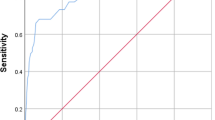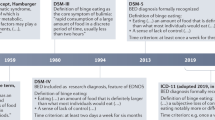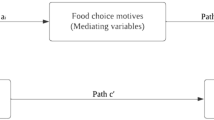Abstract
Objective
Discussion about the potential addictive role of certain types of food and their link with obesity has recently increased. Researchers have developed instruments to specifically assess food addiction (FA). The aim of this pilot study was to investigate the prevalence of food addiction in a nonclinical sample of the Italian population.
Methods
All participants (n = 148: 46 males, 102 females) completed the Yale Food Addiction Scale 2.0 (YFAS 2.0) and provided self-reported measures and demographic information. They were divided into three age groups.
Results
The prevalence of FA was 15.5% of our sample (82.6% of the subjects diagnosed with FA were female). The FA symptoms mean was 1.90 (SD = 2.87). In both sexes, participants aged 18–30 had the highest diagnosis of FA, with 52.1% of all FA subjects being females aged 18–30. According to the Body Mass Index (BMI), all the males diagnosed with FA were overweight or obese, as were most (63.2%) of the FA females.
Conclusions
Future food education policies could consider FA assessment together with that of other eating disorders, even among nonclinical subjects in order to anticipate diagnosis and improve treatment.
This is a preview of subscription content, access via your institution
Access options
Subscribe to this journal
Receive 12 print issues and online access
$259.00 per year
only $21.58 per issue
Buy this article
- Purchase on Springer Link
- Instant access to full article PDF
Prices may be subject to local taxes which are calculated during checkout
Similar content being viewed by others
Data availability
The data presented in this study are available in this published article.
References
Ng M, Fleming T, Robinson M, Thomson B, Graetz N, Margono C. Global, regional and national prevalence of overweight and obesity in children and adults 1980-2013: a systematic analysis for the Global Burden of Disease Study 2013. Lancet. 2014;384:766–81.
Apovian CM. Obesity: definition, comorbidities, causes, and burden. Am J Manag Care. 2016;22:s176–85.
Purnell JQ. Definitions, classification, and epidemiology of obesity. In: Feingold KR, Anawalt B, Boyce A, Chrousos G, de Herder WW, Dungan K, et al. editors. Endotext [Internet]. South Dartmouth (MA): MDText.com, Inc.; 2000.
Brownell KD, Gold M, editors. Food and addiction: a comprehensive handbook. Oxford University Press; 2012. https://doi.org/10.1093/med:psych/9780199738168.001.0001.
Volkow ND, Wang GJ, Tomasi D, Baler RD. Obesity and addiction: neurobiological overlaps. Obes Rev. 2013;14:2–18.
Hebebrand J, Albayrak Ö, Adan R, Antel J, Dieguez C, de Jong J, et al. “Eating addiction”, rather than “food addiction”, better captures addictive-like eating behavior. Neurosci Biobehav Rev. 2014;47:295–306.
Gearhardt AN, Corbin WR, Brownell KD. Preliminary validation of the Yale Food Addiction Scale. Appetite. 2009;52:430–6.
American Psychiatric Association. Diagnostic and Statistical Manual of Mental Disorders. 5th ed. Arlington, VA: American Psychiatric Association, 2013.
Gearhardt AN, Corbin WR, Brownell KD. Development of the Yale Food Addiction Scale Version 2.0. Psychol Addict Behav. 2016;30:113–21.
Davis C, Curtis C, Levitan RD, Carter JC, Kaplan AS, Kennedy JL. Evidence that ‘food addiction’ is a valid phenotype of obesity. Appetite. 2011;57:711–7.
Gearhardt AN, Boswell RG, White MA. The association of “food addiction” with disordered eating and body mass index. Eat Behav. 2014;15:427–33.
Ivezaj V, White MA, Grilo CM. Examining binge-eating disorder and food addiction in adults with overweight and obesity. Obesity. 2016;24:2064–9.
Ivezaj V, Wiedemann AA, Grilo CM. Food addiction and bariatric surgery: a systematic review of the literature. Obes Rev. 2017;18:1386–97.
Penzenstadler L, Soares C, Karila L, Khazaal Y. Systematic review of food addiction as measured with the Yale Food Addiction Scale: implications for the food addiction construct. Curr Neuropharmacol. 2019;17:526–38.
Innamorati M, Imperatori C, Manzoni GM, Lamis DA, Castelnuovo G, Tamburello A, et al. Psychometric properties of the Italian Yale Food Addiction Scale in overweight and obese patients. Eat Weight Disord. 2015;20:119–27.
Aloi M, Rania M, Rodríguez Muñoz RC, Jiménez Murcia S, Fernández-Aranda F, De Fazio P, et al. Validation of the Italian Version of the Yale Food Addiction Scale 2.0 (I-YFAS 2.0) in a sample of undergraduate students. Eat Weight Disord. 2017;22:527–33.
Rostanzo, E. La dipendenza da cibo esiste. PATTO in Cucina Magazine, 2018. https://www.pattoincucina.it/2018/02/12/la-dipendenza-da-cibo-esiste/.
Manzoni GM, Rossi A, Pietrabissa G, Varallo G, Molinari E, Poggiogalle E, et al. Validation of the Italian Yale Food Addiction Scale in postgraduate university students. Eat Weight Disord. 2018;23:167–76.
Imperatori C, Fabbricatore M, Lester D, Manzoni GM, Castelnuovo G, Raimondi G, et al. Psychometric properties of the modified Yale Food Addiction Scale Version 2.0 in an Italian non-clinical sample. Eat Weight Disord. 2019;24:37–45.
Yekaninejad MS, Badrooj N, Vosoughi F, Lin CY, Potenza MN, Pakpour AH. Prevalence of food addiction in children and adolescents: A systematic review and meta-analysis. Obes Rev. 2021. https://doi.org/10.1111/obr.13183.
Pursey KM, Stanwell P, Gearhardt AN, Collins CE, Burrows TL. The prevalence of food addiction as assessed by the Yale Food Addiction Scale: a systematic review. Nutrients. 2014;6:4552–90.
Gonçalves J, Moreira EA, Trindade EB, Fiates GM. Eating disorders in childhood and adolescence. Rev Paul de Pediatr. 2013;31:96–103.
Keski-Rahkone A, Mustelin L. Epidemiology of eating disorders in Europe: prevalence, incidence, comorbidity, course, consequences, and risk factors. Curr Opin Psychiatry. 2016;29:340–5.
Wei NL, Quan ZF, Zhao T, Yu XD, Xie Q, Zeng J, et al. Chronic stress increases susceptibility to food addiction by increasing the levels of DR2 and MOR in the nucleus accumbens. Neuropsychiatr Dis Treat. 2019;15:1211–29.
Yu Z, Indelicato NA, Fuglestad P, Tan M, Bane L, Stice C. Sex differences in disordered eating and food addiction among college students. Appetite. 2018;129:12–8.
Gearhardt AN, White MA, Potenza MN. Binge eating disorder and food addiction. Curr Drug Abus Rev. 2011;4:201–7.
Cinelli G, Criscuolo M, Bifone C, Chianello I, Castiglioni MC, De Lorenzo A, et al. Food addiction in a group of Italian adolescents diagnosed for eating disorder. Nutrients 2020;12:1524.
Tran H, Poinsot P, Guillaume S, Delaunay D, Bernetiere M, Bégin C, et al. Food addiction as a proxy for anorexia nervosa severity: new data based on the Yale Food Addiction scale 2.0. Psychiatry Res. 2020;293:113472.
Pedram P, Wadden D, Amini P, Gulliver W, Randell E, Cahill F, et al. Food addiction: its prevalence and significant association with obesity in the general population. PLoS ONE. 2013;8:e74832.
Puhl RM, Himmelstein MS, Quinn DM. Internalizing weight stigma: prevalence and sociodemographic considerations in US adults. Obesity. 2018;26:167–75.
Acknowledgements
We thank the University of Siena and “PATTO in cucina Magazine” for the support and Dr. Peter Christie for the English revision.
Author information
Authors and Affiliations
Contributions
AMA and ER contributed equally to this paper.
Corresponding author
Ethics declarations
Competing interests
The authors declare no competing interests.
Institutional Review Board Statement
The study was conducted according to the guidelines of the Declaration of Helsinki. Ethical review and approval were waived for this study, since the anonymous nature of the web survey does not allow the tracing of sensitive personal data. Participants were fully informed about the study requirements and had to agree to the data sharing and privacy policy before participating in the study. The study was not a clinical trial on drugs, supplements or foods, but a survey of the population’s habits. All the participants gave their consent to the data treatment at the beginning of the web survey. If any participant did not give his/her consent, the web survey automatically stopped.
Informed consent
Informed consent was obtained from all subjects involved in the study.
Additional information
Publisher’s note Springer Nature remains neutral with regard to jurisdictional claims in published maps and institutional affiliations.
Rights and permissions
About this article
Cite this article
Rostanzo, E., Aloisi, A.M. Food addiction assessment in a nonclinical sample of the Italian population. Eur J Clin Nutr 76, 477–481 (2022). https://doi.org/10.1038/s41430-021-00974-7
Received:
Revised:
Accepted:
Published:
Issue Date:
DOI: https://doi.org/10.1038/s41430-021-00974-7
This article is cited by
-
Food addiction and its relationship with other eating behaviours among Spanish university students
Journal of Eating Disorders (2023)
-
Defining Risky Use in the Context of Food Addiction
Current Addiction Reports (2022)



